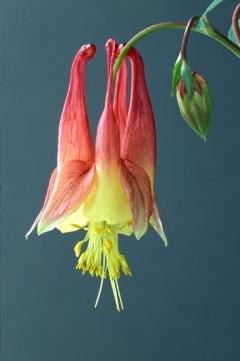Red or Eastern Columbine (Aquilegia canadensis L.)

By Larry Stritch
Columbine is found throughout the Eastern half of the United States and grows in a variety of soil and light conditions that range from woodland edges to riverbanks, and gravelly shores and ridges. Columbine is a beautiful, native wildflower that blooms in late spring with striking 1.5 inch red and yellow flowers held on long stems. It is pollinated by hummingbirds and butterflies.
Growing to a height of 1-2 feet’, columbine does best in partial shade to filtered sun. Germination rates are high and plugs are easily out planted. Tiny black seeds ripen at various times within the flower. They can be collected by hand over several days from August to October by gently tapping the follicle (old flower) into a container. Seeds should be dried for about 2 weeks in open paper bags or containers. When dry they should be stored in sealed, plastic bags and kept in a cool dry place, such as a refrigerator or cold porch, until sowing time. Seeds will stay viable up to 3 years.
Hybridization occurs easily with non-native Aquilegia species. To establish and maintain locally native genotype, all other Aquilegia must be removed.
The genus name Aquilegia comes from the Latin word aquila, which means "an eagle". This reference is specific to the shape of the petals which are said to be like an eagle's claw.
Native Americans prepare infusions from various parts of plants of columbine to treat heart trouble, kidney problems, headaches, bladder problems, and fever, and as a wash for poison ivy. Pulverized seeds were used as love charms and a compound was used to detect bewitchment.
For More Information
PLANTS Profile - Aquilegia canadensis L., Red or Eastern Columbine


